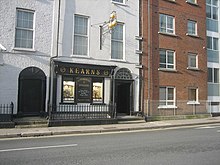Queen Street, Dublin
 northern end of Queen Street | |
| Native name | Sráid na Banríona (Irish) |
|---|---|
| Part of | Smithfield |
| Namesake | Elizabeth I or Catherine of Braganza |
| Type | Street |
| Postal code | D07 |
| Coordinates | 53°20′53″N 6°16′48″W / 53.348096°N 6.279912°W |
| north end | North King Street |
| south end | Arran Quay |
Queen Street (Irish: Sráid na Banríona)[1] is a street in Dublin running from North King Street to Arran Quay.
Location
Queen Street runs from Arran Quay and Mellows Bridge at the south to North King Street to the north. It intersects with a number of historically significant streets, such as Hendrick Street and Benburb Street. Where it meets North King Street, it merges with George's Lane which was widened in 2002.[2]
History
The street dates from 1687, and is believed to have been named for Queen Elizabeth I (r. 1558–1603).[3][4] Although it has been suggested that it may have been named for Catherine of Braganza (queen consort 1662–1685).[5] It is historically part of the city known as Oxmantown, and lies close to the former common green area there.[2][6] Its existence was mandated in 1664, as a highway from the common.[3]
In 1671, the Blue Coat Boys Hospital (King's Hospital) was founded on Queen Street, on the eastern side.[6] This was later redeveloped in lots for housing in 1782 and completed in 1800. These Georgian tenements were later replaced in the 20th century with public housing.[2]
Architecture

A small number of architecturally notable buildings remain on Queen Street, primarily at the junctions with other streets. One such building is 79 Queen Street, the former Dice Bar. Built as a commercial building, it has a date stone of 1770, but the current building dates from circa 1860 and is of typical Victorian styling.[7] A survived pair of Georgian houses, numbers 69 and 70, are now interconnected and in use as a pawnbrokers. These date from circa 1790.[8]
During the 1990s, schemes of flats were developed on Queen Street to infill houses which had been demolished for earlier road widening schemes. These were designed by Shay Cleary, and met with opposition from local politicians including Tony Gregory, who campaigned for houses to be built instead.[9] The scheme went ahead, was completed in 2003,[10] and also saw the development of existing corporation flats on the site.[11] By the early 21st century, large parts of the more commercial end of the street near the quays were used as furniture showrooms.[4]
References
- ^ "Sráid na Banríona/Queen Street". logainm.ie. Retrieved 12 December 2023.
- ^ a b c Casey, Christine (2005). Dublin : the city within the Grand and Royal Canals and the Circular Road with the Phoenix Park. New Haven, Conn.: Yale University Press. pp. 265–266. ISBN 9780300109238.
- ^ a b M'Cready, C. T. (1987). Dublin street names dated and explained. Blackrock, Co. Dublin: Carraig. p. 92. ISBN 1850680000.
- ^ a b Clerkin, Paul (2001). Dublin street names. Dublin: Gill & Macmillan. p. 151. ISBN 0717132048.
- ^ "History". Smithfield and Stoneybatter. Retrieved 9 July 2021.
- ^ a b Lennon, Colm; Montague, John (2010). John Rocque's Dublin : a guide to the Georgian city. Dublin: Royal Irish Academy. p. 5. ISBN 9781904890690.
- ^ "Dice Bar, 79 Queen Street, Benburb Street, Dublin 7, DUBLIN". Buildings of Ireland. Retrieved 9 July 2021.
- ^ "Kearns, 69-70 Queen Street, Dublin 7, DUBLIN". Buildings of Ireland. Retrieved 9 July 2021.
- ^ McDonald, Frank (2000). The construction of Dublin. Kinsale, Co. Cork, Ireland: Gandon Editions. p. 262. ISBN 0946846502.
- ^ "Queen Street". Shay Cleary Architects. Retrieved 9 July 2021.
- ^ "Council to consider scheme for inner-city development". The Irish Times. 11 July 1996. Retrieved 9 July 2021.
External links
 Media related to Queen Street at Wikimedia Commons
Media related to Queen Street at Wikimedia Commons

